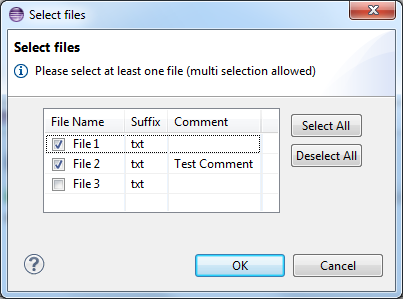





The Input dialog provides many ways of entering, changing or checking parameters for further processing. It generates a dialog field for every input parameter, and outputs the value of the field on confirmation in the parameter memory. Subsequent tools will then have access to these parameters (via parameter from: PREVIOUS_TOOL).

Cancelling an Input dialog means cancelling the complete action. An Input dialog is considered to have been cancelled if it is not confirmed with OK.
The behavior and appearance of the dialog can be modeled more accurately via the attributes of the “Tool has Input Parameter” relationship (see Relationship: Tool has Input Parameter):
| Attribute | Input Dialog field |
|---|---|
| Parameter From | Makes it possible to fill the dialog field. With the “USER_INPUT” attribute value, the field will not be preset with a property value. |
| SeqNo * | Position number of the dialog field. |
| Default Value [O] | Fills the dialog field with this value or a reference, if (depending on the "Parameter_From" attribute) no value is available to the referenced property. |
| Static Value [O] | Sets a fixed value or a reference for this parameter. An input field with “Static Value” cannot be edited. |
| Label [O] | Defines the label of the dialog field. |
| UI Category [O] | Groups dialog fields with the same category. See the The "UI_Category" attibute for more details. For example, “Group with 4 columns/4/” |
| UI Tab [O] |
Assigns parameters to tabs. Tabs will be created only if at least one parameter has this attribute set. Parameters which do not have a tab set will be shown in a tab called “General” by default. If all output parameters of the same dialog tab are determined to be hidden by the evaluation of property enabling conditions, the tab is not shown in the dialog. |
|
UI Editable, UI Generic Allowed, UI Mandatory |
See Relationship: Tool has Input Parameter. |
| UI Multi Selection | See Input Dialog Mass Processing. |


